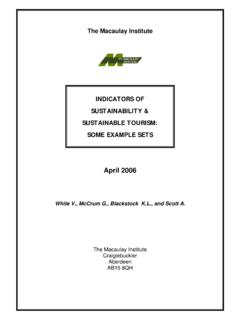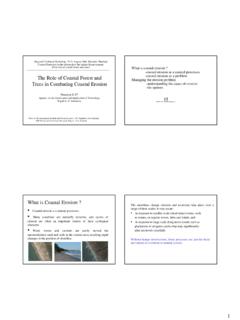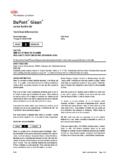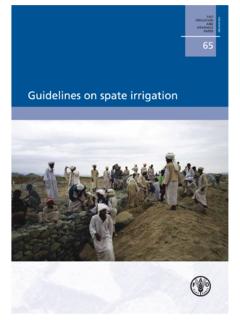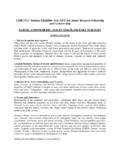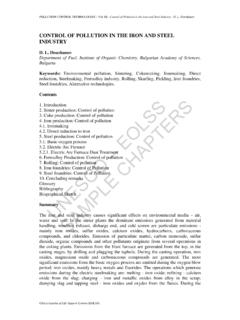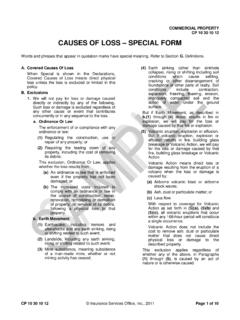Transcription of 4. Soil Physical Damage: Summary of Issues
1 Physical Damage: Summary of IssuesProblemSoil structural degradation; compaction, poaching and quality increased incidence of surface ponding and waterlogging due to low infiltrationrate. changes in soil chemistry under reducing conditions. reduction on rooting depth or even loss of surface quality increased sediment load to rivers and alteration of stream bed conditions. increased load of nutrients, agrochemicals and faecal pathogens to growth reduced air-holding capacity and reduction of oxygen supply to roots. changes in major nutrient cycles due to altered soil chemistry. loss of seedbed contents or exposure of at RiskCompaction: intensive arable production on soils with high silt and clay risk for systems involving multiple passes of machinery under adverse soilconditions ( at or close to field capacity) and systems where yield increases withlate harvesting ( root crops) or where multiple cropping takes place ( silage grass).
2 Poaching: animal production on imperfectly drained soils in the wetter areas in thewest of Scotland. Livestock access to grazings on wet soils, direct access toriver/streams for watering, application of slurries and wastes when soils are erosion : is often associated with intensive arable production onsandy, coarse-textured soils in the East of erosion : in arable systems is commonly experienced on the sandysoils in Moray. However, it also occurs in extensive systems on the organic soilsand peats of the hills and uplands, due to removal of plant cover by heavy grazingPractical ActionsCompaction and poaching soil strength decreases significantly with wetness and,thus, access for machinery and animals should be restricted when soil moisturecontent is at or close to field capacity.
3 Remediation of severe subsoil compaction iscostly and carries with it a risk of further damage because of the use of heavymachinery for soil loosening and deep ploughing. Natural regeneration of compactedtopsoils can take up to 3 years. Avoidance of damage through sound landmanagement is use of engineering solutions such as low ground-pressure tyres, dual wheelsand tracked vehicles may be justified in some cases to widen the operating windowfor land management. Sacrificial systems such as tramlines are now widelyemployed in cropping systems but may act as a point of initiation of erosion eventsduring heavy rainfall events. In the longer term, liming and increasing soil organicmatter contents in mineral soils can encourage the development of good damage by livestock is again amenable to good land managementpractices.
4 Limiting access of stock to wet soils and fencing of sensitive areas, suchas river banks, can all help at the farm It is important to recognise that erosion is a natural process, which can beexacerbated by land use and management. It can then be considered as an off-siteenvironmental hazard but only in extremis does it become a threat to the soilresource itself. It can be significantly reduced by the maintenance of plant coverthroughout the year. Where this is not feasible, arable crop production, reducingthe time interval where bare soil is present can help. The production of very fineseedbeds by power tools has been suggested as a cause of both erosion and surface capping of seedbeds. To limit water erosion , associated with overland flow,contour ploughing is carried out in many countries throughout the world but to amuch lesser extent in Scotland.
5 For arable cropping in Scotland there are bothtechnological and topographical limitations to the application of this PEPFAA Code only addresses these Issues briefly but the MAFF soil Codecontains a much fuller discussion with suggestions for avoiding damage. Thisreflects a difference in focus between the two with the MAFF Code addressingissues of resource management on farms whereas in Scotland the PEPFAA Codeneeds to be supplemented by land management information as bulletins andadvisory notes (SAC).LinkagesNutrient transfersFaecal GapsDevelopment of simple field methods to assess structural stability, strength Physical Damage: Critical Physical structure of soil has been intensively studied by soil scientists overmany decades; indeed, a literature search, using the term soil structure , yieldedover 1,600 references over the past twenty years.
6 Restricting the time period to thelast three years only reduced the number of articles to around 450. Clearly, earlyinterest in the subject has not waned! Similarly, manifestations of Physical damage tosoils, from structural degradation to actual loss of the soil resource itself througherosion processes, holds a continuing interest for soil , environmental and agronomicscientists. However, much of the published work on soil structure is concerned withlargely academic aspects of the subject area. Recently, there has been a particularfocus on the way in which the Physical architecture of the soil provides a mosaic ofmicroenvironments differing in their Physical , chemical and biological properties (Ranjard and Richaume, 2001) and on the development of conceptual models of soilstructure that attempt to identify functional quantification of structure and its causalrelationship to processes (Young et al.)
7 , 2001). An exception to this generalstatement may be found in the topics of tillage and soil compaction by machinerywhere a significant body of knowledge now exists on the impact of various farmoperations associated with arable cropping (Ball et al., 1997)However, in a practical sense, it is probably more useful in a critical analysis toaddress a series of questions, such as: what is soil structure? why should farmers be interested in soil structure? what methods are available for the manipulation and improvement of soilstructure? when is structural damage most likely to occur and how can it be averted? what can be done to remedy damage that has occurred? is soil structure? soil structure has been defined as the spatial heterogeneity of the differentcomponents or properties of soil (Dexter, 1988), although a simpler definition is thethree-dimensional arrangement of particles and pores within the soil .
8 This reviewidentifies the importance of considering a hierarchy of structure work which findsresonance in more recent work utilising the concepts of self similarity over a range ofdimensions as expressed in fractal geometry (Young et al., 2001). should farmers be interested in soil structure?The range of particle sizes found for the mineral and organic components of soil isenormous, ranging from fine clay particles, around 10-7m in diameter, through silt,sand, and gravel to stones up to several centimetres in diameter. If all of thesefractions existed as independent particles then most of our soil resource could not beused for crop growth and agriculture, as we know it. It is only through the influence ofsoil structure that soils possess the qualities required for plant growth andagricultural production.
9 These include a balanced supply of water and oxygen to the16root system of the growing plant, the ability to form seedbeds, a mechanicalanchorage for the root system, the capacity to buffer inputs of rainwater byinfiltration, drainage and evaporation (Dexter, 1988). Many of these functions arecritically dependent on soil porosity which also provides an environment in which soilmicroorganisms live and make their contribution to the turnover of carbon and someof the major nutrients (Ranjard and Richaume, 2001). methods are available for the manipulation and improvement of soilstructure?In response to this question two distinct approaches can be discerned in theliterature. The first of these is concerned with the composition of the soil and theidentification of specific soil components, which are found at higher concentrations intopsoils with greater structural stability.
10 The most widely studied of these aggregating agents is soil organic matter (Carter and Stewart, 1996) while someauthors have focussed on the activity and role of specific components in soil organicmatter ( Ball et al., 1996). The results from the many studies carried out in thisarea is that reductions in soil organic matter content by continuous cultivation canreduce organic matter content and hence increase the probability of structuraldegradation. However, despite the widespread acceptance of this advice, Loveland(2001) has shown that, in a review of over 1500 research papers, very few givesufficiently robust quantitative data whereby critical limits of organic matter contentmight be defined.
